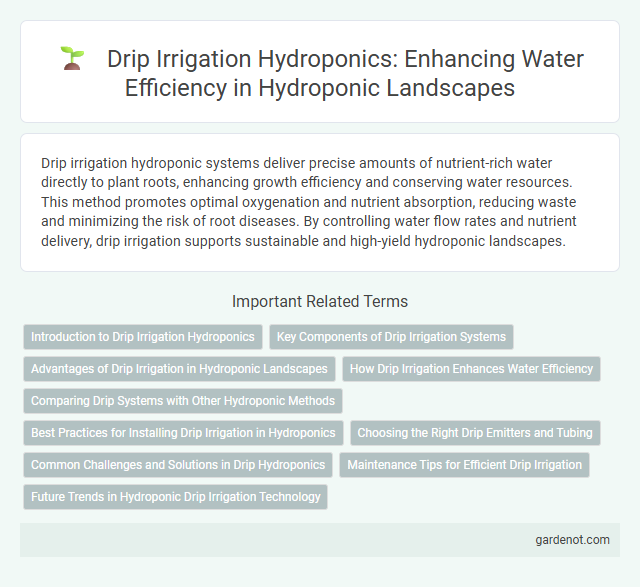Drip irrigation hydroponic systems deliver precise amounts of nutrient-rich water directly to plant roots, enhancing growth efficiency and conserving water resources. This method promotes optimal oxygenation and nutrient absorption, reducing waste and minimizing the risk of root diseases. By controlling water flow rates and nutrient delivery, drip irrigation supports sustainable and high-yield hydroponic landscapes.
Introduction to Drip Irrigation Hydroponics
Drip irrigation hydroponics delivers precise water and nutrient solutions directly to plant roots, optimizing growth while minimizing water waste. This method uses a network of tubes and emitters to maintain consistent moisture levels and nutrient availability, which enhances plant health and yield. Its scalability and efficiency make it ideal for commercial hydroponic farming and sustainable urban agriculture.
Key Components of Drip Irrigation Systems
Drip irrigation hydroponic systems rely on key components such as emitters, tubing, and a water pump to deliver precise nutrient solutions directly to plant roots, enhancing water efficiency and growth rates. Pressure regulators and filters are essential to maintain consistent flow and prevent clogging, ensuring optimal nutrient distribution. Timers and control valves automate irrigation schedules, allowing for precise management of water and nutrient delivery in hydroponic environments.
Advantages of Drip Irrigation in Hydroponic Landscapes
Drip irrigation in hydroponic landscapes ensures precise water and nutrient delivery directly to plant roots, enhancing growth efficiency and reducing water waste. This method minimizes disease risk by keeping foliage dry and supports uniform plant development through consistent moisture levels. Energy savings and automation compatibility further optimize resource use, making drip irrigation a preferred solution for sustainable hydroponic cultivation.
How Drip Irrigation Enhances Water Efficiency
Drip irrigation in hydroponic landscapes delivers precise water and nutrient amounts directly to plant roots, minimizing water wastage through evaporation or runoff. This targeted approach reduces overall water consumption by up to 30% compared to traditional irrigation methods. Efficient water use in drip systems supports sustainable hydroponic growth and promotes healthier plant development.
Comparing Drip Systems with Other Hydroponic Methods
Drip irrigation hydroponic systems deliver precise nutrient solutions directly to plant roots, optimizing water and nutrient usage compared to flood and ebb or nutrient film technique (NFT) systems. Unlike NFT systems that rely on continuous water flow and can be prone to root diseases, drip systems offer controlled moisture levels, reducing the risk of root rot and improving plant health. The scalability and flexibility of drip irrigation make it ideal for diverse crop types and commercial hydroponic operations seeking efficient resource management.
Best Practices for Installing Drip Irrigation in Hydroponics
Drip irrigation in hydroponic landscapes ensures precise nutrient delivery by using emitters that release water directly to plant roots, optimizing growth and resource efficiency. Best practices include selecting uniform emitters to maintain consistent flow rates, regularly monitoring system pressure to prevent clogging, and implementing filtration systems to avoid debris buildup. Proper installation involves securing drip lines near the root zone and adjusting emitter spacing based on plant type and growth stage for maximum yield.
Choosing the Right Drip Emitters and Tubing
Selecting the right drip emitters and tubing is crucial for efficient water delivery in drip irrigation hydroponic systems, ensuring precise nutrient distribution to plant roots. Emitters with adjustable flow rates, typically ranging from 1 to 4 liters per hour, allow customization based on plant size and growth stage. Using UV-resistant polyethylene tubing enhances system durability and prevents clogging, maintaining consistent water flow and optimizing plant health in hydroponic landscapes.
Common Challenges and Solutions in Drip Hydroponics
Drip irrigation hydroponic systems often face common challenges such as clogging of emitters due to nutrient salt buildup and uneven water distribution affecting plant growth. Implementing regular maintenance protocols like flushing lines with clean water and using filtered nutrient solutions helps prevent blockages and ensures consistent drip rates. Optimizing emitter spacing and pressure regulation further enhances uniform nutrient delivery, promoting healthier hydroponic landscapes.
Maintenance Tips for Efficient Drip Irrigation
Regularly inspect drip emitters for clogs caused by mineral deposits or algae to maintain consistent water flow in hydroponic systems. Flush the irrigation lines monthly with filtered water or a mild acid solution to prevent buildup and ensure optimal nutrient delivery. Replace damaged tubing and check for leaks to avoid water waste and maintain system efficiency in hydroponic drip irrigation landscapes.
Future Trends in Hydroponic Drip Irrigation Technology
Future trends in hydroponic drip irrigation technology emphasize the integration of IoT sensors and AI-driven automation to optimize water and nutrient delivery, enhancing crop yield and resource efficiency. Advanced filtration systems and biodegradable drip emitters are being developed to minimize clogging and reduce environmental impact. Precision drip irrigation combined with real-time data analytics enables tailored nutrient management, supporting sustainable and scalable hydroponic farming operations.
Drip irrigation hydroponic Infographic

 gardenot.com
gardenot.com